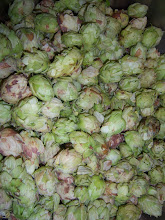 before I retired it for posterity, so this was my nefarious plan. Plus, some easy-drinking hoppy beer has been in demand for a while now: certain critics who prefer to remain nameless (ahem! Elli! ahem!) have been clear regarding where my brewing brewing priorities should be. Consider this a problem solved.
before I retired it for posterity, so this was my nefarious plan. Plus, some easy-drinking hoppy beer has been in demand for a while now: certain critics who prefer to remain nameless (ahem! Elli! ahem!) have been clear regarding where my brewing brewing priorities should be. Consider this a problem solved.109. American Pale Ale w/ Edinburgh Yeast
Mash:
8 lbs. Muntons Pale Ale (Pearl)
1 lb. Weyerman Light Munich
½ lb. Muntons Crystal 60° L
½ lb. Dingemans Cara 45° L
½ lb. Dingemans Cara 20° L
½ lb. Breiss White Wheat
Mashed @ 152° F w/4 ½ gallons of RO water for 60 minutes; collected 3 gallons @ 1.060
Batch sparged @ 168° F w/3 ½ gallons RO water for 20 minutes; collected 3 ½ gallons @ 1.024
Collected 6 ½ gallons; brought to a boil (60 minute) and added:
w/60 to go: ½ lb. white table sugar
1 oz. Magnum pellet 10.0% AA
w/15 to go: 1 tsp. Irish Moss
w/10 to go: ¾ oz Amarillo leaf 10.7% AA
w/5 to go: ¾ oz Amarillo leaf 10.7% AA
w/0 to go: ¾ oz Amarillo leaf 10.7% AA
Chilled, racked onto White Labs WLP 028 Edinburgh Ale cake from 108. Lucci Cup Scottish 80 Schilling
Brewed: 2/11/2012 @ 66° F
Secondary: 2/16/2012 @ 1.014
Bottled: 3/1/2012 w/ 3.0 oz. table sugar
OG: 1.054
FG: 1.014
Tasting Notes: (4/16/2012) This beer didn’t turn out quite like I expected—while it is certainly malt forward via the yeast, the hops—and specifically the Amarillo components of those ho
 ps—are incognito in the nose and flavor. Instead, we’ve got a malty and bready beer with a touch of bitterness that reminds me more of the Rockit Cup Alt than anything really resembling an APA (although the malt character between the two is also different via the 100% Dark Munich used in the Rockit Cup Alt, which give the beer a chewy and delicately fruity but clean malt character, while here malt is more bread crust and cereal). That said, I think it is a delightful beer—it’s just not anything like an APA, regardless of intention and hop profile: the lower yeast attenuation (FG: 1.014) and rounded malt character covers hop aroma and flavor. Some actual comments:
ps—are incognito in the nose and flavor. Instead, we’ve got a malty and bready beer with a touch of bitterness that reminds me more of the Rockit Cup Alt than anything really resembling an APA (although the malt character between the two is also different via the 100% Dark Munich used in the Rockit Cup Alt, which give the beer a chewy and delicately fruity but clean malt character, while here malt is more bread crust and cereal). That said, I think it is a delightful beer—it’s just not anything like an APA, regardless of intention and hop profile: the lower yeast attenuation (FG: 1.014) and rounded malt character covers hop aroma and flavor. Some actual comments:Edinburgh APA pours an orange toffee; it is lightly hazy with a tan head that rouses easily and lingers pleasantly. The nose is fresh bread crust and dough mixed with caramel; there was a touch of hop bitterness at first, but it faded almost instantaneously. Flavors start bright and almost crisp—there is cereal and graininess along with malt breadiness before giving away to the touch of bitterness in the middle, which lingers into the finish. There is also caramel sweetness leading into the finish along with a touch of toffee, but the bitterness cleans it up to finish bright with a touch of dry biscuit flavor. The body is medium as is the carbonation, although the bubbles brighten the beer on the tongue. Clean, even, balanced, this beer certainly reflects the yeast far more than anything else in the recipe. While it didn’t turn out as I expected, it is still a pleasant and easy-drinking beer—I’ve already worked through about half of it, and it still tastes fresh and bright. Not quite the hopy beer I was requested to make. Nonetheless, here’s to happy accidents!

Just stumbled onto your site - great! I too was looking for a nefarious way to hit the Edinburgh cake from my last scotch ale. This might just be the way to go. Any other thoughts or improvements you'd make? I'm looking through my hop stash...
ReplyDeleteI tried something similar during my recent APA yeast experiment: http://whatweredrinking.blogspot.com/2012/07/american-pale-ale-yeast-experiment.html
ReplyDeleteThe lighter malt bill (mostly Pilsener) made it more like an APA, but again with a more rounded, malty body via the Edinburgh yeast--that version was closer to an APA, although it still ended up with a higher FG (I'll pull the information from home and post it tomorrow so you can compare the FGs for the three different yeasts). Both that and this were enjoyable beers--the darker crystal malt here and residual sugar covered over the hop flavor, although the bitterness made it through. Certainly something worth trying, though.